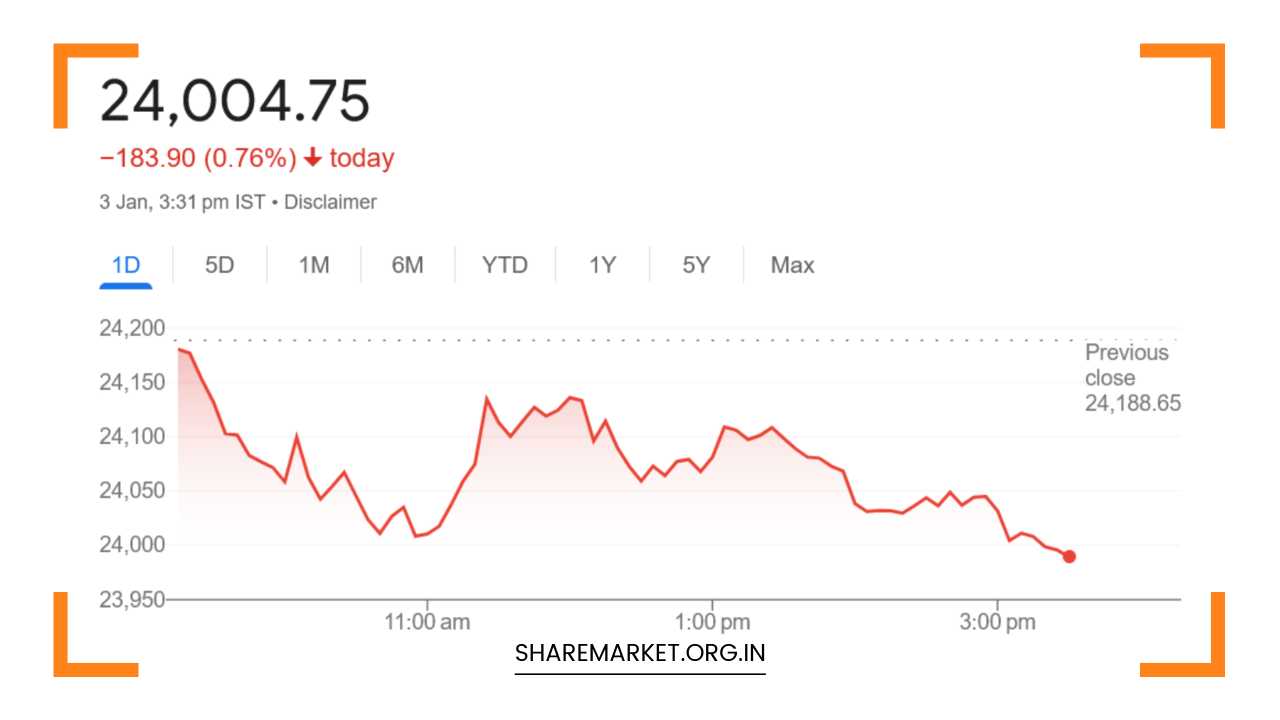Sensex Down 720 Points, Nifty at 24,004; Nifty Prediction for Monday

Nifty Prediction for Monday
Profit Booking After Two Days of Gains: What’s Next for the Market on January 6?
Market Overview: The Indian stock market experienced a correction on January 3, 2025, following two days of positive momentum.
The benchmark indices, Sensex and Nifty, both ended the trading session lower after profit booking took hold.
The Sensex closed at 79,223.11, down by 720.60 points or 0.90%, while the Nifty settled at 24,004.75, falling by 183.90 points or 0.76%.
Despite the retreat, the market has shown mixed behavior, with certain sectors and stocks holding up better than others.
In total, 2,048 stocks gained during the session, while 1,778 stocks lost ground, and 111 stocks remained unchanged, indicating a broad divergence in performance across various sectors.
Among the sectoral indices, banks, capital goods, IT, and pharma sectors faced significant losses, each dropping by approximately 1%.
On the other hand, oil and gas and media stocks showed some resilience, gaining about 1% each. The BSE Midcap Index closed lower by 0.33%, while the Smallcap Index remained flat, reflecting caution among retail investors and a preference for large-cap stocks in the current environment.
Sectoral Performance Analysis
Wipro, ICICI Bank, HDFC Bank, Tech Mahindra, and Adani Ports were among the biggest losers on the Nifty. These stocks were under pressure, driven by broader market trends and sector-specific issues.
For example, banking stocks were weighed down by concerns over rising interest rates and the slower-than-expected recovery in credit growth.
Similarly, IT stocks faced headwinds due to weaker-than-anticipated growth prospects in the global outsourcing market.
On the other hand, ONGC, Tata Motors, SBI Life Insurance, Titan Company, and Hindustan Unilever (HUL) emerged as the top gainers of the day.
These stocks demonstrated resilience, primarily driven by strong sector-specific fundamentals and investor optimism surrounding domestic consumption and infrastructure-related investments.
Oil and gas stocks, led by ONGC, benefitted from a rebound in crude oil prices, while companies in the consumer goods space, such as Titan and HUL, gained on expectations of continued demand growth in the Indian economy.
Technical Insights: Market Moving Forward
From a technical perspective, Rajesh Palviya, the Technical Research Head at Axis Securities, pointed out that the recent pullback in the market was a technical reaction from oversold levels.
He views the ongoing consolidation phase after the market’s sharp recovery as a healthy sign for the broader market. Such phases are essential for the market to stabilize and digest the previous gains.
During consolidation, it is common to see buying interest shift toward beaten-down stocks and sectors, which can lead to an improvement in market breadth.
Palviya further elaborated that the market’s next big move could be influenced by various factors, including corporate earnings for the third quarter of FY25, the upcoming Union Budget, and the potential policy changes following the U.S. presidential transition.
He emphasized that these factors, combined with a strengthening market breadth, create an environment that could support further upward movement in the market once consolidation completes.
However, he cautioned that investors should be prepared for continued volatility in the short term as the market digests all these macro and microeconomic developments.
Key Resistance and Support Levels for Nifty
Akshay Chinchalkar, Research Head at Axis Securities, outlined important technical levels to watch for Nifty.
According to Chinchalkar, the immediate resistance for Nifty stands at 24,250, with the next major resistance coming in at 24,306.
These levels represent key technical barriers that, if surpassed, could pave the way for further bullish movement in the index.
On the downside, the first support level is seen at 24,000. If the index breaks below this crucial level, the next significant support zone is likely to be around 23,830.
These support levels will play a pivotal role in determining the near-term direction of the market. A breach of these support levels could trigger further selling, while a successful defense of the 24,000 level may help the market stabilize and prepare for another rally.
External Factors Weighing on Market Sentiment
Despite a brief recovery in the last two trading sessions, several external factors continue to weigh on the market’s sentiment.
Prashant Tapase, Senior Analyst at Mehta Equities, highlighted the ongoing pressures stemming from sluggish economic growth, expensive stock valuations, foreign fund outflows, and geopolitical uncertainties, particularly regarding U.S. trade policies.
The uncertainty surrounding the U.S. presidential transition is a key concern for global markets, especially in terms of potential changes in trade policies and economic diplomacy.
Tapase suggested that the Indian market, while showing some signs of resilience, could face additional rounds of corrections in the coming weeks, especially if global macroeconomic conditions do not improve.
In such an environment, investors are likely to remain cautious, closely monitoring both domestic and international developments.
A renewed period of selling pressure, particularly from foreign institutional investors (FIIs), could exacerbate market volatility in the short term.
Third-Quarter Earnings and the Union Budget: Catalysts for Market Movement
Looking ahead, the third-quarter corporate earnings season is expected to be a key determinant of the market’s direction.
While analysts expect some sectors, like banking and IT, to face challenges, others, such as consumer goods and infrastructure, are likely to show resilience.
The market’s response to these earnings results could provide clarity on the overall health of the economy and corporate profitability.
Another major event to watch is the upcoming Union Budget, which is scheduled to be presented in February 2025. Expectations surrounding fiscal measures, tax reforms, and government spending on infrastructure and social welfare could significantly impact investor sentiment.
Positive announcements in these areas could offer a much-needed boost to the market, while any disappointment could trigger further caution.
Market Prediction for January 6, 2025
As the market heads toward January 6, the direction will likely depend on a combination of domestic factors, including earnings results and the Union Budget, and external factors, such as global economic data and geopolitical developments.
If the market successfully defends key support levels, particularly at 24,000, it could pave the way for a resumption of the upward trend.
Conversely, any negative global cues or domestic disappointments could put further pressure on the indices, leading to additional corrections.
Given the ongoing consolidation and profit booking in the market, investors should be prepared for a period of volatility.
However, the broader outlook remains constructive, with the possibility of stronger market breadth and sector rotation providing support for longer-term growth.
Final Remarks
The Indian stock market remains in a state of flux, caught between short-term volatility and long-term optimism.
While consolidation and profit booking are typical after a period of strong gains, the market’s underlying fundamentals remain intact.
Investors will need to stay vigilant and adjust their strategies based on evolving economic conditions, both domestically and globally.
With key technical levels to watch and several important events on the horizon, including corporate earnings and the Union Budget, the market’s trajectory over the coming weeks will depend on how these factors unfold.

















